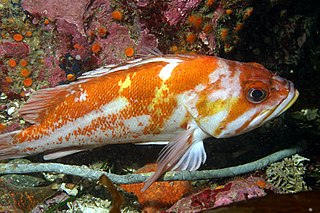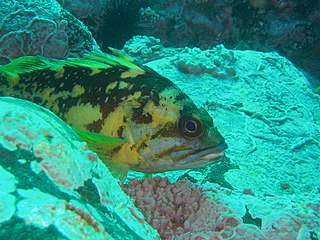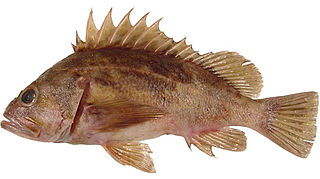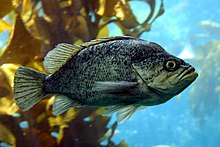
The Southern California Bight is a 426-mile-long stretch of curved coastline that runs along the west coast of the United States and Mexico, from Point Conception in California to Punta Colonet in Baja California, plus the area of the Pacific Ocean defined by that curve. This includes the Channel Islands of California and the Coronado Islands and Islas de Todo Santos of Baja California.

The blue rockfish or blue seaperch, is a species of rockfish of the northeastern Pacific Ocean, ranging from northern Baja California to central Oregon.

The canary rockfish is a rockfish of the northeast Pacific Ocean, found from south of Shelikof Strait in the eastern Gulf of Alaska to Punta Colonet in northern Baja California.

The Pacific ocean perch, also known as the Pacific rockfish, Rose fish, Red bream or Red perch has a wide distribution in the North Pacific from southern California around the Pacific rim to northern Honshū, Japan, including the Bering Sea. The species appears to be most abundant in northern British Columbia, the Gulf of Alaska, and the Aleutian Islands.

The copper rockfish, also known as the copper seaperch, is a fish of the family Sebastidae.

Paralabrax clathratus, the kelp bass, bull bass or calico bass, is a species of marine ray-finned fish, a sea bass from the subfamily Serraninae, classified as part of the family Serranidae which includes the groupers and anthias. It is found in the eastern North Pacific Ocean where it is an important species for both recreational and commercial fisheries.

The false jacopever or Cape redfish is a marine fish belonging to the family Sebastidae. Found only in waters off the western coast of South Africa, Tristan da Cunha and southern South America, S. capensis lives in depths of 20 to 275 metres. It reaches up to 37 centimetres (15 in) in length, and is reddish or brownish with 5–6 pale spots on the upper part of the body. It has extremely prominent eyes. It mainly feeds on mysids.

The bocaccio is a northeast Pacific species in the Sebastidae (rockfish) family. Other names for this species include salmon grouper, grouper, tom cod (juveniles), and slimy. In Greek, sebastes means "magnificent", and paucispinis is Latin for "having few spines".

Sebastes entomelas, the widow rockfish, is a type of rockfish (Sebastidae) that lives mainly off the coast of western North America from Alaska to Baja California. This fish is also commonly called widowfish and red snapper.

Sebastes miniatus is a species of rockfish known by the common names vermilion rockfish, vermilion seaperch, red snapper, red rock cod, and rasher. It is native to the waters of the Pacific Ocean off western North America from Baja California to Alaska.

Sebastes goodei is a type of rockfish (Sebastidae) that lives mainly off the coast of western North America from Baja California to Vancouver. It is commonly called the chilipepper rockfish and chilipepper seaperch.

The yelloweye rockfish is a rockfish of the genus Sebastes, and one of the biggest members of the genus. Its name derives from its coloration. It is also locally known as "red snapper", not to be confused with the warm-water Atlantic species Lutjanus campechanus that formally carries the name red snapper. The yelloweye is one of the world's longest-lived fish species, and is cited to live to a maximum of 114 to 120 years of age. As they grow older, they change in color, from reddish in youth, to bright orange in adulthood, to pale yellow in old age. Yelloweye live in rocky areas and feed on small fish and other rockfish. They reside in the East Pacific and range from Baja California to Dutch harbor in Alaska.

Sebastes chrysomelas, commonly known as the black-and-yellow rockfish, is a marine fish species of the family Sebastidae. It is found in rocky areas in the Pacific off California and Baja California. Although it is similar in appearance to the China rockfish, the black-and-yellow rockfish lacks the China's long yellow streak. The China rockfish has a continuous yellow band while the black-and-yellow rockfish only has scattered patches of yellow across its body.

The quillback rockfish is one of 130 species of rockfish and primarily dwells in salt water reefs. The average adult weighs 2–7 pounds and may reach 1 m in length. Quillback rockfish are named for the sharp, venomous quills or spines on the dorsal fin. Their mottled orange-brown coloring allows them to blend in with rocky bottom reefs. The quillback rockfish eats mainly crustaceans, but will also eat herring. They are solitary and minimally migratory, but not territorial, and give birth to live young (viviparous). They are a popular sport fish, generally caught in cold water 41–60 m deep, but also to subtidal depths of 275 m.

The brown rockfish, whose other names include brown seaperch, chocolate bass, brown bass, and brown bomber, is a species of ray-finned fish in the family Sebastidae.

Oxyjulis californica is a species of wrasse native to the eastern Pacific Ocean along the coasts of California and Baja California. Its distribution extends from Salt Point in Sonoma County, California, to southern central Baja California, near Cedros Island. It is a very common species; its common name in Spanish is señorita.

Sebastes babcocki is a species of fish in the rockfish family known by the common name redbanded rockfish. Other common names include bandit, barber pole, flag rockfish, Spanish flag, Hollywood, convict, and canary. It is native to the northern and eastern Pacific Ocean. Its distribution extends from the Zhemchug Canyon in the Bering Sea and the Aleutians south to San Diego, California.

Sebastes reedi is a species of fish in the rockfish family found in the Eastern Pacific.

Sebastes diaconus, the deacon rockfish, is a rockfish of the genus Sebastes.

Sebastes ciliatus is a species of rockfish also commonly known as dusky rockfish. It is typically found in the North Pacific Ocean, specifically in the Bering Sea near British Columbia, in the Gulf of Alaska, and in the depths of the Aleutian Islands.




















